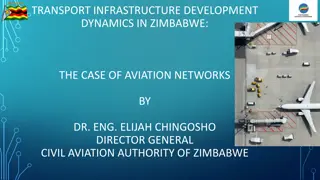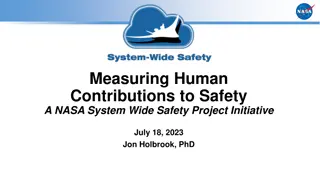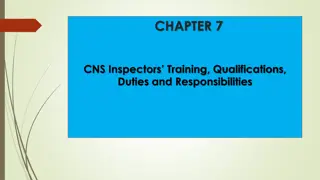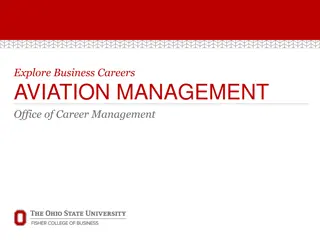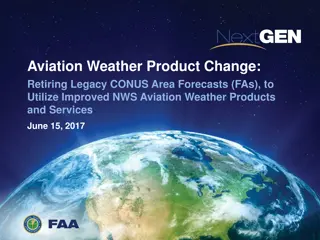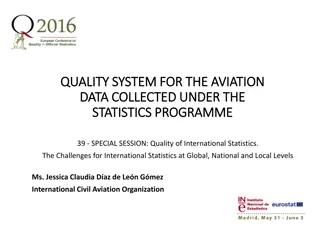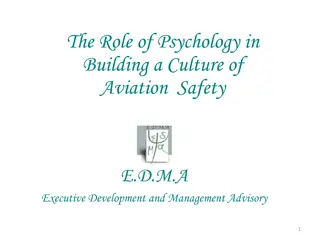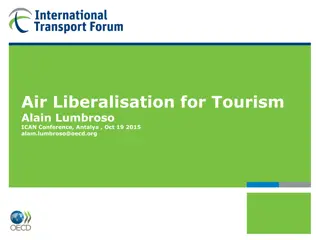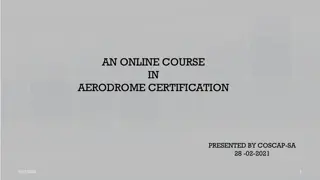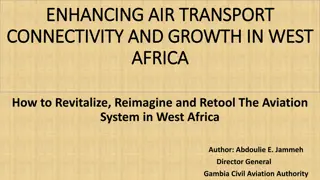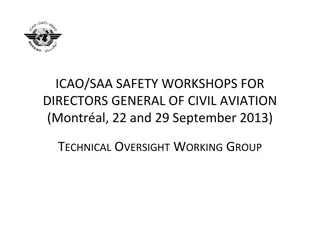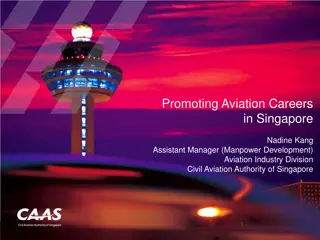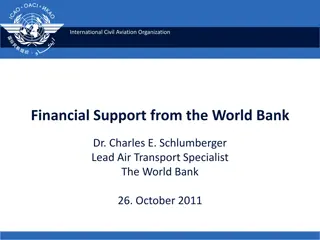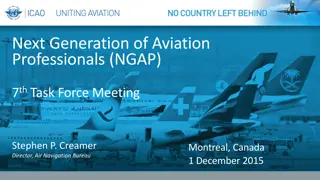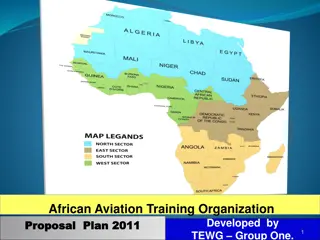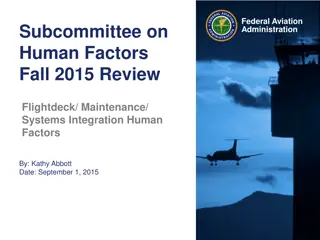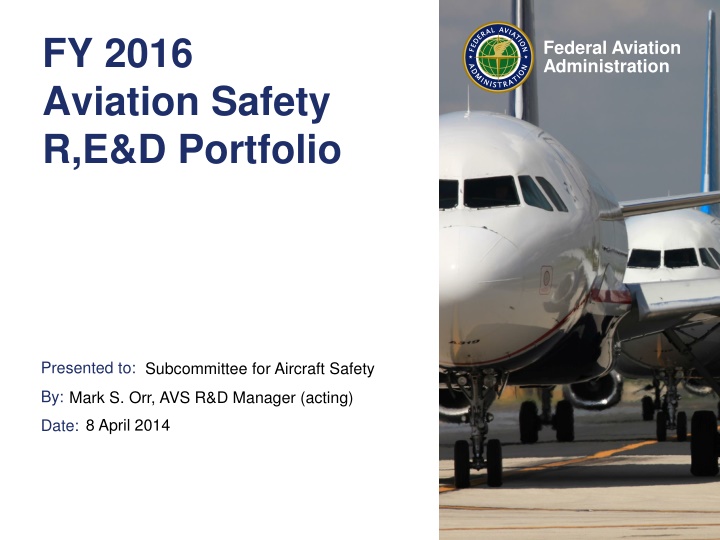
Aviation Safety R,E&D Portfolio Overview
The FY 2016 Aviation Safety R,E&D Portfolio presented by Mark S. Orr provides insights into the mission, vision, and development process of the Federal Aviation Administration's aviation safety research and development activities. The portfolio focuses on goals, research areas, and strategic guidance to enhance aviation safety and performance.
Download Presentation

Please find below an Image/Link to download the presentation.
The content on the website is provided AS IS for your information and personal use only. It may not be sold, licensed, or shared on other websites without obtaining consent from the author. If you encounter any issues during the download, it is possible that the publisher has removed the file from their server.
You are allowed to download the files provided on this website for personal or commercial use, subject to the condition that they are used lawfully. All files are the property of their respective owners.
The content on the website is provided AS IS for your information and personal use only. It may not be sold, licensed, or shared on other websites without obtaining consent from the author.
E N D
Presentation Transcript
FY 2016 Aviation Safety R,E&D Portfolio Federal Aviation Administration Presented to: Subcommittee for Aircraft Safety By: Mark S. Orr, AVS R&D Manager (acting) 8 April 2014 Date:
Outline Aviation Safety RE&D Mission and Vision Portfolio Development Process (planned and current) FY16 Portfolio Requirements Summary Accomplishments & Activities Backup Slides Requirements by technical area and budget line Budget line item overview quad charts FY 2016 Aviation Safety R,E&D Portfolio (r3) 4 March 2014 Federal Aviation Administration 2
Aviation Safety RE&D Mission Top level goals of the PPT portfolio Support Destination 2025 Goals Move to the next level of safety Deliver aviation access through innovation Sustain our future Improve global safety and environmental performance through collaboration Conduct research that advances aviation safety in the interest of the flying public and the millions who rely on the aviation industry for business, pleasure and commerce To fulfill this mission, research is focused on: Continued operational safety Certification Standards and policy FY 2016 Aviation Safety R,E&D Portfolio (r3) 4 March 2014 Federal Aviation Administration 3
RE&D Vision Lifecycle approach to RE&D Outcome based Driven by safety risks Active Sponsorship Project-based research requirements Approve initial project requirement once Measure and manage project to obtain project outputs FY 2016 Aviation Safety R,E&D Portfolio (r3) Federal Aviation Administration 4 4 March 2014
AVS RE&D Lifecycle Model FY 2016 Aviation Safety R,E&D Portfolio (r3) Federal Aviation Administration 5 4 March 2014
Portfolio Development Process Plan AVS-1 provides strategic guidance Performer Cost Estimates Submitted TCRGs develop research requirements Sponsors & OPIs review requirements for submittal AVS RED Group Technical Prioritization AVS RED Group Prioritization with Costs ATO-F provides budget targets for PPTs SAS reviews portfolio (3-4-2014) AVS MT reviews final portfolio (4-29-2014)) Safety PPT reviews portfolio AVS Services/Offices review priority list Presentation of portfolio to the REB (2-20-2014 through 4-14-2014) PPT develops budget narratives FY 2016 Aviation Safety R,E&D Portfolio (r3) Federal Aviation Administration 6 4 March 2014
FY16 RE&D Process Timeline Milestone Complete Date FY16 AVS Strategic Guidance issued Training conducted for all stakeholders AVS Service and Office pre-submittal review All TCRG requirements submitted AVS RED Group Prioritization completed Top 61 priority list released for cost estimates Performer cost estimates submitted AVS RED Group proposed portfolio completed FY16 portfolio released for review AVS Office/Service Level Reviews completed Portfolio presented to PPT for review Portfolio presented to REB Portfolio presented to SAS Portfolio presented to AVSMT Call for Lessons Learned Final FY16 budget preparation develop narratives 5/?/2014 Notes 5/24/2013 5/7,14/2013 9/20/2013 9/20/2013 (All AVS requirements due) 11/21/2013 (delay Oct to Nov - shutdown) 11/22/2013 11/29/2013 1/15/2014 1/17/2014 2/28/2014 2/7/2014 2/3,10,20/2014 3/4-6/2014 4/29/2014 5/?/2014 FY 2017 process begins FY17 Strategic Guidance issued April 2014 FY 2016 Aviation Safety R,E&D Portfolio (r3) Federal Aviation Administration 7 4 March 2014
By the Numbers Requirements submitted = 90 5 requirements funded by AVS Weather Slice 5 requirements sent to NextGen program Cost estimates requested = 61 Requirements programmed = 57 50 programmed to requested medium (desired) level 7 programmed to requested low level FY 2016 Aviation Safety R,E&D Portfolio (r3) Federal Aviation Administration 8 4 March 2014
R,E&D Contract Targets FY16 initial target = $42.64M FY15 initial target = $43.9M FY14 enacted = $37.9M ($42.3M initial) FY16 AVS Weather Safety target = $3.5M FY15 initial target = $3.5M FY14 enacted = $3.28M ($3.5M initial) FY 2016 Aviation Safety R,E&D Portfolio (r3) Federal Aviation Administration 9 4 March 2014
PPT Financial Summary (ao 2/19/14) FY 15 Request FY 16 Target FY 14 Enacted In-House Contracts In-House Contracts Program Title In-House Contracts Base Program (RE&D) 3,582 4,000 3,558 3,240 3,769 3,000 A11.a / Fire Research and Safety 633 1,100 767 1,600 737 2,350 A11.b / Propulsion and Fuel Systems 870 1,475 905 1,950 924 2,050 A11.c / Advanced Materials/Structural Safety A11.d / Atmospheric Hazards/Digital Systems Safety 1,864 5,004 2,059 3,719 2,000 5,028 2,870 5,633 2,857 6,581 2,902 6,985 A11.e / Continued Airworthiness A11.f / Aircraft Catastrophic Failure Prevention Research 278 1,210 337 1,200 336 1,100 A11.g / Flightdeck/Maintenance/System Integration HF 3,677 1,324 3,860 5,850 3,758 6,240 2,185 9,002 2,294 5,526 2,452 3,750 A11.h / System Safety Management 5,856 1,837 5,759 2,992 6,241 3,987 A11.j / Aeromedical Research 653 13,547 705 17,129 619 17,589 A11.k / Weather Program 1,315 7,329 1,191 7,614 1,441 8,300 A11.l / Unmanned Aircraft Systems Research Base RE&D Subtotal 23,783 51,461 24,292 57,401 21,579 60,379 FY 2016 Aviation Safety R,E&D Portfolio (r3) Federal Aviation Administration 10 4 March 2014
PPT Financial Summary (ao 2/19/14) FY 15 Target FY 16 Target FY 14 Enacted Contracts In-House Contracts In-House Contracts Program Title In-House NextGen Program (RE&D) 292 5,708 288 5,412 305 5,442 A11.m / General Aviation Alternative Fuels 0 1,000 A11.n / Aircraft System Safety 385 10,944 396 10,092 352 9,353 A12.c / NextGen - Air Ground Integration A12.d / NextGen - Self Separation A12.e / NextGen - Weather Technology in the Cockpit 845 3,155 818 3,599 832 3,248 NextGen RE&D Subtotal 1,522 20,807 1,502 19,103 1,489 18,043 NextGen Program (F&E) 1A08G / System Safety Management Transformation1 8,000 7,200 7,900 8,000 7,200 7,900 NextGen F&E Subtotal PPT Total 1,522 28,807 1,502 26,303 1,489 25,943 1. Values are estimates per the 2013 NARP. FY 2016 Aviation Safety R,E&D Portfolio (r3) Federal Aviation Administration 11 4 March 2014
FY16 Aviation Safety Core RE&D Contracts (ao 2/19/14) A11.a / Fire Research & Safety, $3,000 , 5% A11.b / Propulsion & Fuel, $2,350 , 4% A11.c / Advanced Materials/Structural Safety, $2,050 , 3% A11.k / Wx Program, $17,589 , 29% A11.d / Atmospheric Hazards/Digital System Safety, $5,028 , 8% A11.e / Cont'd Airworthiness, $6,985 , 12% A11.f / Aircraft Catastrophic Failure Prevention, $1,100 , 2% A11.l / UAS, $8,300 , 14% A11.j / Aeromedical, $3,987 , 7% A11.g / Human Factors, $6,240 , 10% A11.h / SSM (includes TAS), $3,750 , 6% Total - $60,379 FY 2016 Aviation Safety R,E&D Portfolio (r3) Federal Aviation Administration 12 4 March 2014
FY16 Aviation Safety NextGen RE&D Contracts (ao 2/19/14) A11.m / NextGen- Alternative Fuels for General Aviation, $5,442 , 21% 1A08G / System Safety Management Transformation, $7,900 , 30% A12.c / NextGen - Air Ground Integration Human Factors, $9,353 , 36% A12.e NextGen Weather Technology in the Cockpit, $3,248 , 13% Total - $25,943 FY 2016 Aviation Safety R,E&D Portfolio (r3) Federal Aviation Administration 13 4 March 2014
Aviation Safety Core BLI Totals (ao 2/19/14) $10,000 $9,000 $8,000 $7,000 $6,000 FY12 FY13 FY14 $5,000 FY15 FY16 $4,000 Average $3,000 $2,000 $1,000 $- A11.a A11.b A11.c A11.d A11.e A11.f A11.g A11.h A11.j A11.l FY 2016 Aviation Safety R,E&D Portfolio (r3) Federal Aviation Administration 14 4 March 2014
Accomplishments & Activities Deployed updated prioritization process Cover-to-cover update (last major revision in 2006) Incorporated process changes made through AVS Strategic Guidance Focused on Life Cycle Model and Active Sponsorship Sets the stage for future move to project vs. yearly requirement management Deployed new ranking criteria Alignment with Safety Risk language Updated guidance materials for authors and reviewers FY 2016 Aviation Safety R,E&D Portfolio (r3) Federal Aviation Administration 15 4 March 2014
Backup Slides a) Draft Portfolio by TCRG b) Draft Portfolio Quad Charts by Budget Line FY 2016 Aviation Safety R,E&D Portfolio (r3) Federal Aviation Administration 16 4 March 2014
Draft Portfolio by TCRG FY 2016 Aviation Safety R,E&D Portfolio (r3) Federal Aviation Administration 17 4 March 2014
Aircraft Icing (AI) Proposed FY2016 Budget Control Acct # FY 2016 Requirement BLI ICA Research on Ice Crystal Icing Conditions to Support Means of Compliance A11D.AI.1 A11.d $ 200 ICA Safe Operations and Take-off in Aircraft Ground Icing Conditions A11D.AI.2 A11.d $ 520 PCA Simulation Methods Development / Validation to Support Appendix C Icing Certification and Continued Operational Safety A11D.AI.3 A11.d $ 432 A11D.AI.5 SLD Engineering Tools Development and Validation A11.d $ 300 AI $ 1,452 FY 2016 Aviation Safety R,E&D Portfolio (r3) Federal Aviation Administration 18 4 March 2014
Aeromedical (AAM) Proposed FY2016 Budget $ 684 $ 959 $ 240 $ 66 $ 1,949 Control Acct #FY 2016 Requirement A11J.AM.1 CAMI Aerospace Medical Systems Analysis A11J.AM.2 CAMI Accident Investigation & Prevention A11J.AM.3 CAMI Crash Survival A11J.AM.4 CAMI Aerospace Physiology AM BLI A11.j A11.j A11.j A11.j FY 2016 Aviation Safety R,E&D Portfolio (r3) Federal Aviation Administration 19 4 March 2014
Electrical Systems (ES) Proposed FY2016 Budget Control Acct # FY 2016 Requirement BLI A11E.ES.3 Fuel Cell Systems for Aircraft Applications A11.e $ 900 A11E.ES.4 Rechargeable Lithium Batteries and Battery Systems for Aircraft Applications A11.e $ 1,300 ES $ 2,200 FY 2016 Aviation Safety R,E&D Portfolio (r3) Federal Aviation Administration 20 4 March 2014
Fire & Cabin Safety (FCS) Proposed FY2016 Budget Control Acct # FY 2016 Requirement BLI A11A.FCS.1 Aircraft Fire Safety A11.a $ 3,000 A11C.FCS.1 Transport Airplane Ditching A11.c $ 300 A11C.FCS.2 Airframe structural crashworthiness response characterization A11.c $ 200 A11J.FCS.1 Evacuation Analytical Tools A11.j $ - A11J.FCS.3 Injury criteria for obliquely oriented seats A11.j $ 1,400 System level crashworthiness injury criteria and certification methodology A11J.FCS.4 A11.j $ 350 A11J.FCS.5 Evacuation Equipment/Aids A11.j $ 138 FCS $ 5,388 FY 2016 Aviation Safety R,E&D Portfolio (r3) Federal Aviation Administration 21 4 March 2014
Flight Controls & Mechanical Systems (FCMS) Proposed FY2016 Budget Control Acct # FY 2016 Requirement BLI A11E.FCMS.4Preventing Loss of Control in Part 23 by Safer Automation using Envelope Protection A11.e $ 450 A11E.FCMS.5 Flightcrew Strength and Anthropometric Design Assurance (FSADA) A11.e $ 250 A11E.FCMS.6 Tire Failure Characteristics A11.e $ 350 FCMS $ 1,050 FY 2016 Aviation Safety R,E&D Portfolio (r3) Federal Aviation Administration 22 4 March 2014
Human Factors (HF) Proposed FY2016 Budget Control Acct #FY 2016 Requirement Enhancing Aviation Safety Through Advanced Procedures, Training & Checking Methods, to include Loss of Control Detection, Avoidance, and Recovery BLI A11G.HF.1 A11.g $ 1,200 Avionics & New Technologies: Certification and Operational Approval Criteria A11G.HF.2 A11.g $ 1,000 A11G.HF.3 Human Factors Maintenance Risk Management A11.g $ 600 Advanced Vision Systems (EFVS, EVS, SVS, and CVS), Head Up Displays (HUD), Head Mounted Displays (HMD): Certification and Operational Approval Criteria A11G.HF.4 A11.g $ 600 A11G.HF.5 Unmanned Aircraft Systems (UAS) Human Factors Considerations A11.g $ 900 A11G.HF.7 Human Factors R&D for Improved Rotorcraft Operational Safety A11.g $ 1,590 A11G.HF.8 HF Fatigue Mitigation in Flight Operations A11.g $ 350 $ 6,240 FY 2016 Aviation Safety R,E&D Portfolio (r3) Federal Aviation Administration 23 4 March 2014
Maintenance & Inspection (MI) Proposed FY2016 Budget Control Acct #FY 2016 Requirement BLI A11E.MI.3 Flight Data Monitoring System Installation, Helicopter Operations A11.e $ 175 MI $ 175 FY 2016 Aviation Safety R,E&D Portfolio (r3) Federal Aviation Administration 24 4 March 2014
Propulsion Systems (PS) Proposed FY2016 Budget Control Acct # A11B.PS.1Advanced Damage Tolerance and Risk Assessment Methods for Engine Life-Limited Parts (New Materials) FY 2016 Requirement BLI A11.b $ 1,600 A11B.PS.3 Volcanic Ash Engine Ingestion A11.b $ 750 Advanced Analysis Methods for Impact of Composite Aircraft Materials in Rotor Burst and Blade Release A11F.PS.1 A11.f $ 1,100 PS $ 3,450 FY 2016 Aviation Safety R,E&D Portfolio (r3) Federal Aviation Administration 25 4 March 2014
Rotorcraft Systems (RS) Proposed FY2016 Budget Control Acct # FY 2016 Requirement BLI A11E.RS.1 Health and Usage Monitoring System (HUMS) A11.e $ 900 A11E.RS.3 Continued Operational Safety of Rotorcraft A11.e $ 250 RS $ 1,150 FY 2016 Aviation Safety R,E&D Portfolio (r3) Federal Aviation Administration 26 4 March 2014
Software Digital Systems (SDS) Proposed FY2016 Budget Control Acct # FY 2016 Requirement BLI A11D.SDS.1 Onboard Network Security and Integrity A11.d $ 1,500 A11D.SDS.2 Software Development Techniques and Tools A11.d $ 500 A11D.SDS.3 Airborne Electronic Hardware Design Techniques and Tools A11.d $ 676 A11N.SDS.1 NextGen_System Considerations for Complex Software Intensive Systems A11.d $ 900 SDS $ 3,576 FY 2016 Aviation Safety R,E&D Portfolio (r3) Federal Aviation Administration 27 4 March 2014
Structural Integrity Composites (SIC) Proposed FY2016 Budget $ 850 $ 425 $ 275 Control Acct # FY 2016 Requirement A11C.SIC.1 Damage Tolerance of Composite Structures A11C.SIC.2 Composite Maintenance Practices A11C.SIC.5 Structural Integrity of Adhesive Joints BLI A11.c A11.c A11.c A11C.SIC.7 PCA-Composite Materials Handbook 17 (CMH-17, formerly MIL-HDBK-17) A11.c $ - SIC $ 1,550 FY 2016 Aviation Safety R,E&D Portfolio (r3) Federal Aviation Administration 28 4 March 2014
Structural Integrity Metallics (SIM) Proposed FY2016 Budget Control Acct # FY 2016 Requirement Risk Assessment and Risk Management Methods for Small and Transport Airplane COS BLI A11E.SIM.1 A11.e $ 200 A11E.SIM.3 Emerging Technology Active Flutter Suppression A11.e $ 500 A11E.SIM.4 MMPDS Support and Design Values for Emerging Materials Damage Tolerance and Durability Issues for Emerging Technologies Probabilistic Approach to Detecting Fatigue Damage Before Developing an Unsafe Condition SIM A11.e $ 125 A11E.SIM.5 A11.e $ 1,435 A11E.SIM.6 A11.e $ 150 $ 2,410 FY 2016 Aviation Safety R,E&D Portfolio (r3) Federal Aviation Administration 29 4 March 2014
System Safety Management (SSM) Proposed FY2016 Budget Control Acct # FY 2016 Requirement BLI A11H.SSM.9 Helicopter FDM Data Gathering and Analysis for ASIAS A11.h $ 850 SSM $ 850 FY 2016 Aviation Safety R,E&D Portfolio (r3) Federal Aviation Administration 30 4 March 2014
Terminal Area Safety (TAS) Proposed FY2016 Budget Control Acct # A11H.TAS.1Develop models that enhance the ability to use Advanced Flight Simulators for Advanced Maneuvers FY 2016 Requirement BLI A11.h $ 800 A11H.TAS.2 PCA - Determining Runway Friction from Airplane Data A11.h $ 500 A11H.TAS.3 Simulator Motion Cueing Criteria A11.h $ 800 A11H.TAS.5Helicopter operational safety improvements using advanced vision systems TAS A11.h $ 800 $ 2,900 FY 2016 Aviation Safety R,E&D Portfolio (r3) Federal Aviation Administration 31 4 March 2014
Unmanned Aircraft Systems (UAS) Proposed FY2016 Budget Control Acct # FY 2016 Requirement BLI A11L.UAS.1 Sense and Avoid (SAA) system certification obstacles A11.l $ 175 A11L.UAS.2Sense and Avoid (SAA) System Multi-sensor Surveillance Data Fusion Strategies A11L.UAS.6Collect and Analyze UAS Safety Data from the Congressionally Mandated Test Sites A11.l $ 1,900 A11.l $ 1,500 A11L.UAS.7 UAS System Safety Criteria A11.l $ 400 A11L.UAS.10 Integration of ACAS-X Into SAA for UAS A11.l $ 2,900 A11L.UAS.11Certification Test Case to Validate UAS Industry Consensus Standards A11.l $ 625 A11L.UAS.15UAS Maintenance, Modification, Repair, Inspection, Training, and Certification Considerations A11.l $ 800 $ 8,300 UAS FY 2016 Aviation Safety R,E&D Portfolio (r3) Federal Aviation Administration 32 4 March 2014
Weather (WX) Proposed FY2016 Budget $ 1,400 Control Account # A11K.WX.2 Terminal Area Icing Weather Information System Mitigating the Ice Crystal Weather Threat to Aircraft Turbine Engines Using Data Linked Aircraft Sensed Weather Information to Determine Probability of Icing Conditions Aloft Validation of Performance Standards of Onboard Eddy Dissipation Rate Systems for Turbulence and Wake Applications FY 2016 Requirement BLI A11.k A11K.WX.3 A11.k $ 400 A11K.WX.6 A11.k $ 700 A11K.WX.8 A11.k $ 1,000 $ 3,500 FY 2016 Aviation Safety R,E&D Portfolio (r3) Federal Aviation Administration 33 4 March 2014
Draft Portfolio Quad Charts by Budget Line FY 2016 Aviation Safety R,E&D Portfolio (r3) Federal Aviation Administration 34 4 March 2014
A11.a Fire Research and Safety Destination 2025 Goals Research Goals Contributes to the achieving Next Level of Safety outcomes by reducing fire risks, and the prevention of accidents and fatalities associated with aircraft fires. Improve flammability standards for critical aircraft interior materials Improve passenger and freighter aircraft fire protection means and occupant fire survivability Supports International Leadership Initiatives to Advance Global Collaboration through cooperation with EASA and other authorities in Fire Safety working groups. Need Technologies, procedures, test methods, and fire performance criteria that can prevent and, where necessary, mitigate, aircraft fires and improve survivability during a post-crash fire. FY 2016 Accomplishments Out Year Funding Requirements Generalized flammability test method for hidden materials Large-scale fire tests on magnesium alloy ducting FY 2019 FY 2020 FY 2016 FY 2017 FY 2018 Prototype sensor that discriminates between fire and non-fire events Funding Target ($000) 3,000 Initial design of an on-board fire detection and extinguishment system for cabin attic space Fire characteristics of large-format lithium cells and batteries Initial design of a system to protect against a fuel cell APU leaking hydrogen gas Fire spread capability added to CFD hidden fire model FY 2016 Aviation Safety R,E&D Portfolio (r3) Federal Aviation Administration 35 4 March 2014
A11.b Propulsion and Fuel Systems Destination 2025 Goals Contribute to achieving Next Level of Safety outcomes by reducing risks of engine and fuels system failures or malfunctions, and the prevention of accidents and fatalities associated with these hazards. Research Goals Develop damage tolerance methods and data that are used to improve engine design and reduce the risk of engine rotor failure. Improve certification basis for engines: updated/new certification standards and advisory circulars. Need Develop a risk based methodology for volcanic ash outlining the impact on performance and inspection requirements while operating safely within the demonstrated fleet envelope. Improve the safety, airworthiness, reliability, and performance of propulsion and fuel systems. FY 2016 Accomplishments Out Year Funding Requirements Develop Advanced Damage Tolerance and Risk Assessment Methods and tools and implement in the DARWIN code as applicable that improved fleet risk assessment methods that combine physics based models for fatigue failure modes, anomaly descriptions, stress and thermal analysis information, and NDE inspections. FY 2019 FY 2020 FY 2016 FY 2017 FY 2018 Funding Target ($000) 2,350 Report documenting the results of the engine teardown after ash ingestion documenting ash particle size vs. concentration vs. noted degradation of component. FY 2016 Aviation Safety R,E&D Portfolio (r3) Federal Aviation Administration 36 4 March 2014
A11.c Advanced Materials/Structural Safety Destination 2025 Goals Research Goals Develop guidance and training for the field bonded and composite repair practices. Contributes to achieving the Next Level of Safety outcomes by reducing structural risks of composite aircraft, and the prevention of accidents and fatalities associated with these hazards. Develop standards to support regulatory policy for the qualification and quality control of metal bonded structures. Supports FAA International leadership in composite safety and certification initiatives. Need Develop a detailed outline for guidance on analysis and test protocol to evaluate crashworthiness in transports fabricated from new materials/structural concepts. Update guidelines and standards for emerging bonded airframe technology. Identify critical characteristics of composite/metal hybrid structural substantiation: proof-of-structure, static strength, fatigue and damage tolerance. Prevent accidents associated with use of advanced materials in airframe structure and improve the crashworthiness of airframes. Collect data and other background information required to update Advisory Circular 20-107B (and issue AC 20-107C). Technical data to support future rulemaking and the development of policy, guidance and training materials needed to support aviation industry compliance with FAA regulations. Develop standards to support regulatory policy on the crashworthiness requirements of all aircraft types. FY 2016 Accomplishments Out Year Funding Requirements Document severe impact damage mechanisms from simulated service vehicle collisions and effect on structural properties. Outline test and analysis guidelines to assure designs are resistant to such damage. Provide detailed background on the unique static, fatigue, environmental durability and impact performance of advanced composite splicing concepts. FY 2019 FY 2020 FY 2016 FY 2017 FY 2018 Complete an evaluation of field bonded and bolted repair practices to update related guidance and training for composite aircraft structures. Funding Target ($000) 2,050 Develop information on the affect of environmental and heat exposure on structural properties and durability of composite structures. Provide documentation and background data for regulatory action to assure reliable processing of adhesively bonded structural. Assess loading rates for emergency landing conditions at the component and system level including occupant survivability. Identify issues and limitations associated with structural scale and boundary effects on crash analysis. This deliverable is at risk if the FY16 funding for this requirement is not available (currently not selected by FAA process). FY 2016 Aviation Safety R,E&D Portfolio (r3) Federal Aviation Administration 37 4 March 2014
A11.d Aircraft Icing/Digital System Safety Destination 2025 Goals Research Goals This research contributes to achieving Next Level of Safety outcomes by reducing icing weather threats to aircraft and engines and risks of failures or malfunctions of software and digital systems, and the prevention of accidents and fatalities associated with these hazards. Need Engineering tools to support means of compliance and guidance material for engine and airframe rulemaking and technology changes that effect certification and operations in supercooled large drop, mixed phase, and ice crystal icing conditions. Standards and guidance for safe ground icing operations. Means of compliance for complex and highly integrated airborne digital systems implemented using software or electronic hardware, including COTS technology . Regulations, standards, guidance, and training for aircraft cyber security Evaluate and validate methods and supply guidance and standards for engineering tools needed to support certification of engines in simulated high ice water content environments. Develop data, detection, and awareness methods for evaluating aircraft operations in high ice water content environments. Develop SLD engineering tools and improved guidance materials to support means of compliance for new icing regulations. Identify mitigation techniques and prevention measures to address safety issues associated with use of software and airborne electronic hardware in aircraft systems. Identify and make recommendations to mitigate cyber security vulnerabilities that may affect aircraft safety. Out Year Funding Requirements FY 2016 Accomplishments Compare data from flight research field campaign with the current Appendix D ice crystal icing engineering standard to determine if additional rulemaking is required. Provide draft guidance materials on ice crystal engineering tools to update means of compliance. Determine if low speed rotation effects associated with anti-icing fluids in control surface gaps requires policy changes. Complete testing of swept wing ice shapes at low Reynolds Number to support validation of 3-D ice accretion codes. Develop mitigation approaches to address selected COTS issues used in aircraft systems implemented in electronic hardware. Identify approaches to determine worst case execution time (WCET) for multi-core processors with multi-threading running on two or more processor cores. Evaluate and make recommendations for selected net-centric architecture s and wireless connectivity from collaborative aircraft systems simulators/emulators Identify complexity factors as input to certification efforts using complex digital systems. FY 2019 FY 2020 FY 2016 FY 2017 FY 2018 Funding Target ($000) 5,028 FY 2016 Aviation Safety R,E&D Portfolio (r3) Federal Aviation Administration 38 4 March 2014
A11.e Continued Airworthiness Destination 2025 Goals Research Goals Contribute to achieving Next Level of Safety outcomes by addressing continued airworthiness safety risks related to the aircraft structure, engines, and systems. This research contributes to the prevention of accidents and fatalities associated with these hazards. Need Assure continued operational safety through development of technologies, procedures, technical data, and performance models. Facilitate safe implementation of new materials and technologies for metallic and hybrid structures for certification and COS maintain/update industry standards and practices (e.g., MMPDS & NASGRO); data to support development of regulatory policy and guidance; bridge engineering requirements with maintenance/inspection technology and practices. Develop effective countermeasures to address loss of control and aerodynamic stall, wheel & tire failure, GA pilot disorientation, and small airplane structural fatigue to reduce general aviation accidents; and account in rules for pilot demographics Develop helicopter Flight Data Monitoring (FDM) system/equipment installation guidance, continued airworthiness/oversight policy, and program implementation guidance. FY 2016 Accomplishments Develop risk assessment and risk management methods and data for Small (e.g., RA&RM) and Transport Airplane COS (e.g., TARAM), including damage tolerance and durability data for emerging materials. Enable development of standards and regulations for new energy efficient electrical power generation and storage systems with reduced risks of accidental fires. Maintain and distribute standards (MMPDS, NASGRO) for existing and emerging material technologies (e.g., Al-LI, additive manufacturing); develops technical data to support implementation of new technology for certification and COS (e.g., bonded repairs). Improve Rotorcraft Safety by fully utilizing health and usage monitoring, advanced control systems and bird strike avoidance. Produce validated wheel and tire failure models, strength and anthropometrics for current pilot populations; and develop certification methods support GA pilot situational awareness Out Year Funding Requirements Acquire, install and flight test low cost, lightweight FDM systems in the Tech Center research helicopter to evaluate systems, installations and locations. FY 2019 FY 2020 FY 2016 FY 2017 FY 2018 Collect and analyze the flight data for the various systems, installations, and locations as compared to the research helicopter flight test instrumentation (baseline) and provide a report for systems comparison, installation, and location optimization recommendations. Funding Target ($000) 6,985 Characterize design constraints, operating risks and safety factors for hydrogen fuel cells and non-flammable battery electrolytes for civil aerospace use. FY 2016 Aviation Safety R,E&D Portfolio (r3) Federal Aviation Administration 39 4 March 2014
A11.f Aircraft Catastrophic Failure Prevention Research Destination 2025 Goals Research Goals This research contributes to achieving Next Level of Safety outcomes by reducing risks of engine failure and associated accidents and fatalities. Develop acceptable procedures for applying the Uncontained Engine Debris Damage Assessment Model (UEDDAM) code to demonstrate compliance to 23.903 and 25.903. Develop acceptable procedures for applying the LS-DYNA finite element code to demonstrate compliance to 33.19 and 33.94. Need Develop related guidance materials such as: Standardize analysis methods and tools for evaluating potential hazards and risks related to engine rotor burst and fan blade failure to assure that regulatory compliance findings are accurate and consistent. Case studies, best practices, code limitations Material characteristics database and characterization guidance FY 2016 Accomplishments Out Year Funding Requirements Advanced Analysis Methods for Impact of Composite Aircraft Materials in Rotor Burst and Blade Release . Complete Planned improvements to Metallic Material Model MAT224, to include von Mises, Generalized Yield and Anisotropy analysis options Complete initial development of a new material model for Composite Failure. MAT213 will be developed and implemented in LSDYNA FY 2019 FY 2020 FY 2016 FY 2017 FY 2018 Funding Target ($000) 1,100 FY 2016 Aviation Safety R,E&D Portfolio (r3) Federal Aviation Administration 40 4 March 2014
A11.g - Flight Deck / Maintenance / System Integration Human Factors Destination 2025 Goals Next Level of Safety; Delivering Aviation Access through Innovation Need Research Goals Provide data to support evaluation criteria and methods, regulatory material, and recommended practices related to human factors for flight deck systems and applications/functions, flightcrew procedures, training, and operational use Human error s are regularly cited as contributing and causal factors in accidents and incidents Research is needed to identify and address human factors issues during standards development (ACs, Orders, and specific TSOs), especially considering new technology and operations. Establish data to support risk management programs to address hazards in the maintenance environment FY 2016 Accomplishments Out Year Funding Requirements Data to support updated training guidance for Crew Resource Management and pilot monitoring Data to address HF-related operational issues with use of airport moving maps, ADS-B, & EFB Research report (s) on HF integration issues with tablet (e.g., iPad) technology in the flight deck Research report(s) on proposed UAS Ground Control Station requirements Maintenance LOSA advisory materials, implementation support, and effectiveness assessment. FY 2019 FY 2020 FY 2016 FY 2017 FY 2018 Funding Target ($000) 6,240 FY 2016 Aviation Safety R,E&D Portfolio (r3) Federal Aviation Administration 41 4 March 2014
A11.h System Safety Management1 Destination 2025 Goals Research Goals Integrate distributed digital or textual data into operational performance and safety information. Achieve Next Level of Safety outcomes by reducing safety risks through data analysis, modeling, and simulation. Improve monitoring and analyses of air traffic operations. Need Enhance risk assessment processes for certification and Continued Operational Safety. Anticipation of system-wide operational risks. Develop objective criteria for simulator platform motion and create satisfactory stall models for upset recovery training. Additional data-driven approaches. Validate on-board measures of braking effectiveness Lower accident rate due to loss-of-control. Develop inspector guidance for hover taxi to/through movements. Fewer runway excursions. Improved helicopter safety. FY 2016 Accomplishments Out Year Funding Requirements Expand aviation safety data sets, further automated processing capabilities, and develop tools for data fusion. Test tools to facilitate oversight of operational safety. FY 2019 FY 2020 FY 2016 FY 2017 FY 2018 Implementation plan for relaying slipperiness condition to future arrivals. Funding Target ($000) 3,750 Propose new simulator objective motion criteria. Note: 1. Includes Terminal Area Safety Pilot-in-the-loop simulator evaluation of selected helo EVS/SVS/HMD system FY 2016 Aviation Safety R,E&D Portfolio (r3) Federal Aviation Administration 42 4 March 2014
A11.j Aeromedical Research Destination 2025 Goals Research Goals Identify criteria for restraint systems that protect occupants at high impact levels. This research contributes to achieving Next Level of Safety outcomes by reducing health and safety risk to aircraft crew and passengers. Develop numerical model validation parameters that evaluate aircraft evacuation designs and emergency response capability. This research contributes to achieving Improve Global Performance Through Collaboration outcomes by providing inputs to private and public organizations domestically and internationally. Need Develop gene expression, toxicology, and bioinformatics technology and methods to define human response to aerospace stressors. Identify safety strategies addressing pilot impairment, incapacitation and other factors that contribute to loss of aircraft control. Provide up-to-date guidance and standards to enhance human safety, security, and survivability in civilian aerospace operations. Develop methods to extract aeromedical information for prognostic identification of human safety risks. FY 2016 Accomplishments Assess injuries and their relationship to autopsy findings, medical certification data, aircraft cabin configurations, and biodynamic testing. AM 1 - Aeromedical Systems Analysis: Integrate a high performance computational (HPC) analytic engine allowing statistical analysis of aeromedical safety issues: disqualifying pathologies. AM -2 Accident Investigation & Prevention: Develop a liquid chromatography/mass spectrometry method to quantitate the presence of synthetic and natural cannabinoids in postmortem fluids and tissues. AM-3 Crash Survival: Evacuation - Persuasive Technology: Assessments of the passenger comprehension of onboard safety briefing materials. AM-4 Aviation Physiology: Assess the clinical effects of cabin altitude during air travel on patients with pulmonary disease. F&CS-2 Develop Injury criteria for certification of obliquely oriented seats F&CS-3 Develop Evacuation Analytical Tools for use in certification F&CS-5 Develop System level crashworthiness injury criteria and certification methodology to support advisory material F&CS-6 Develop Evacuation Equipment/Aids to support future requirements Out Year Funding Requirements FY 2019 FY 2020 FY 2016 FY 2017 FY 2018 Funding Target ($000) 3,837 FY 2016 Aviation Safety R,E&D Portfolio (r3) Federal Aviation Administration 43 4 March 2014
A11.l Unmanned Aircraft Systems Research Provide data in support of UAS requirements, airworthiness standards, certification procedures, and safety criteria. This research contributes to achieving Next Level of Safety outcomes by safely integrating UAS technologies and capabilities into the airspace system. Identify barriers for certification of systems and equipment providing acceptable sense and avoid capabilities. This research contributes to achieving Deliver Aviation Access Through Innovation outcomes by seamlessly integrating UAS technologies and capabilities into the airspace system to meet user demand. Need Develop certification standards, policy, and guidance needed to safely integrate UAS into the NAS Determine FAA requirements for evaluation of unique UAS equipment , systems, associated NAS operations. Identify safety thresholds based on UAS characteristics to determine safety impacts to other aircraft and people in the air and on the ground. FY 2016 Accomplishments Out Year Funding Requirements Collect and analyze operational data to document key issues related to the safe integration of UAS in the NAS Continue development of UAS standards, interoperability and civil certification requirements, and maintenance requirements. FY 2019 FY 2020 FY 2016 FY 2017 FY 2018 Funding Target ($000) 8,300 Continue development of UAS safety thresholds to help determine airworthiness requirements for UAS Provide aircraft certification test case to validate small UAS industry consensus standards. FY 2016 Aviation Safety R,E&D Portfolio (r3) Federal Aviation Administration 44 4 March 2014



